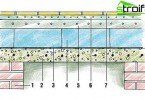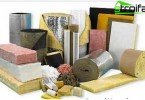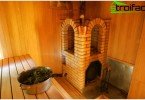During the construction of the bath, a number of requirements and rules must be observed. Roof and ceiling insulation should be carried out taking into account the nuances of the structure. A good vapor and heat insulation is necessary in the bath, especially the roof and ceiling, since hot air tends to rise up. Therefore, even at the construction stage, it is necessary to achieve maximum heat preservation in the steam room with the simultaneous absence of condensate. Indeed, it is rare for any bathing lover to enjoy large drops of cold water falling from the ceiling onto a heated body. No less important is the question of how to insulate the roof of the bath. This is what we will talk about in our article..
Content
- Bathhouse roof insulation
- The better to insulate
- Steam and waterproofing
- How to insulate the roof of the bath
Bathhouse roof insulation
The better to insulate
If the bath is used only for its intended purpose, then the roof should not be particularly insulated. It will be enough of high-quality heat and vapor insulation of the ceiling of the room and the laid roofing material on the roof lathing in front of the roof covering. Capital insulation of the roof is required if you intend to use the space under it as a room for storing and drying brooms, bath equipment, clean linen.
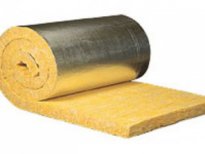
One of the types of insulation intended for the roof of the bath – mineral wool with a foil side
The modern building materials market is rich in various insulation materials. Typically, foam, glass wool, mineral wool and materials such as RokWool and URSA are used. Penoplex slabs, which can withstand temperatures from -50 ° to + 75 °, have gained great popularity (because of this they can not be used for steam rooms). This material has several advantages:
- durability;
- uniformity;
- moisture resistance;
- ease of insulation;
- durability twice as high as polystyrene foam.
In addition, the use of penoplex removes the problem of vapor barrier, since it does not absorb moisture at all.
From the whole variety of materials you need to choose the most suitable for your own preferences and financial capabilities.
Interesting: there are folk ways to warm the bath, for example, coating the roof with clay with sawdust or using reeds. Moreover, in the second method, with the correct laying of the stems, high protection against snow and rain and excellent vapor barrier are guaranteed.
Paro – and waterproofing
Before starting the insulation of the roof, all its elements must be thoroughly treated with compounds from decay and means that protect against fire. Rafters and beams must also be impregnated with antiseptics and flame retardants. As a waterproofing material, membrane films are usually used, which serve as a kind of barrier to water that can penetrate even the smallest coating defects. The film, which serves as a waterproofing, is laid out on the rafters before installing the crate, and the one serving as a vapor barrier – between the sewing and the ceiling insulation.
The film is laid freely, without tension, with an overlap of 15-20 cm. The sheets are glued together with adhesive tape. This will help prevent stretch marks and tears during thermal deformation of the material..
How to insulate the roof of the bath
Most popular a heater for the roof of the bath considered basalt fiber (mineral wool). It has remarkable thermal insulation properties and is a completely natural material. When insulating the roof with mineral wool, it is necessary to prepare a layer of a heat insulator consisting of two rows of a ten-centimeter insulation, laid in a checkerboard pattern. The finished layer is placed in the roofing cake.
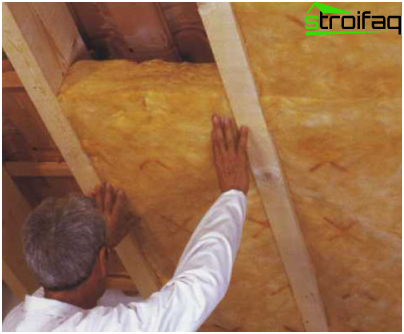
How to insulate the roof of the bath from the attic with mineral wool
The main advantage of this method is its high reliability and the absence of cold bridges formed when the joints overlap. Of course, this method is expensive, so some builders, trying to save money, replace a ten-centimeter insulation with a five-centimeter insulation and additionally protect the roof by laying a double layer of vapor barrier film.
An even cheaper way is to use foam panels instead of basalt fiber, but due to the release of toxic phenol fumes when heated, this method can only be used for external insulation.
Materials and methods of ceiling insulation
Insulation of the ceiling is necessary, as it provides:
- Steam accumulation inside the steam room.
- Protecting the roof and attic from moisture.
- No condensation on the ceiling.
- Heat preservation.
What to use for thermal insulation
So, how to insulate the ceiling of the bath? There are many modern heaters, which are thin heat and vapor barrier, consisting of a warming layer and foil. But on their own they are not able to cope with condensate. In order to eliminate this problem, it is necessary to lay another layer of insulation, which can be used as:
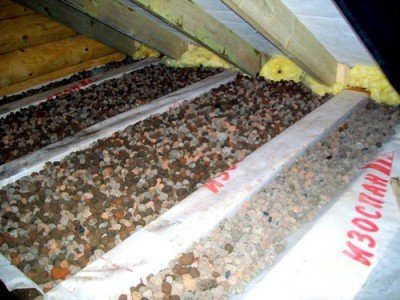
Expanded clay – one of the most effective materials for warming the ceiling of the bath
- Basalt fiber. Its advantages include low thermal conductivity, naturalness and fire resistance. The disadvantage – when wet, mineral wool completely loses all its properties.
- Expanded clay. It keeps heat excellent, but it must be poured with a very thick layer (at least 30 cm) and its use requires additional vapor and waterproofing.
- Clay with sawdust. The oldest method, the cheapest, but very troublesome. Such a layer must be filled with dry earth to a height of at least five centimeters.
Important: if mineral wool is chosen as a ceiling insulation, then for a long preservation of its properties it is necessary to arrange a gap in front of the waterproofing film to ensure air access.
Options for insulation of the ceiling in the bath
We move on to the next question that arises during the construction of baths and saunas – how to insulate ceiling in the bath.
Since ancient times, people have been using bathhouses. Naturally, there are a large number of warming options, both ancient and modern. In this article we will focus on the most common methods: using modern heaters and using natural materials.
Thermal insulation of log bath ceilings
First you need to sheathe the entire ceiling with blocks of at least six centimeters thick. Next, a vapor barrier is laid, which is used as board impregnated with linseed oil or aluminum foil. This layer must be covered with soft clay and only then should you start laying the insulation, the thickness of which should be more than 150 mm. As an insulation layer in this method, the use of:
- expanded clay;
- sand;
- land;
- clay with sawdust;
- mineral wool.
Interesting: clay with sawdust prevents the breeding of mice in the roof of the bath.
If a room is planned on the roof of the bath, then boards are laid on top of the insulation. Otherwise, you can do with a cement screed with sand.
Important: special attention when warming should be given to the place near the pipe outlet.
“Layered” bath ceiling
- 1 way. On a beam of 20×20 cm in size, a continuous ceiling of 25 mm sheet pile boards covered with a double layer of drying oil is suspended. Planks are laid over the beams, between which gaps must be left. Next, a layer of roofing material, polyethylene or foil is spread. The next layer is 200 mm of sand or slag.
- 2 way. The ceiling along the beams is hemmed from below by unedged boards of 50 mm, which are supported on the side of the steam room by a 50 mm board on the wood grouse. A ceiling with air gaps is laid on this board, preferably from an aspen lining. The next stage is the installation of a vapor barrier (cardboard), on which a mixture of clay with sawdust is coated with a layer of 30 mm. Next, mineral wool 150 mm thick is laid, followed by an airtight film. After that, you can lay the attic boards.
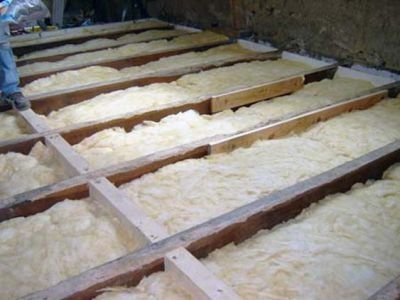
Insulation of the bath with mineral wool (basalt fiber)
Clay ceiling insulation with clay
Well, finally, we give an old way of warming the ceiling of the bath, time-tested and highly reliable.
The ceiling is assembled from dry boards and sheet piles with a thickness of at least 40 mm. Gaps formed during laying are covered with thick clay without adding sand. After the clay solution has completely dried, the ceiling is covered with a clay layer, but already with sand. Its thickness should be 50-60 mm, and the consistency of clay – as for oven masonry. Again, after complete drying, dry sand is poured to a height of at least 100 mm.
When the bath is working, first the clay softens, soaking in moist steam, and then, when dry heat forms in the room, the clay dries very quickly and retains heat very well, so the temperature in the steam room remains for a long time.
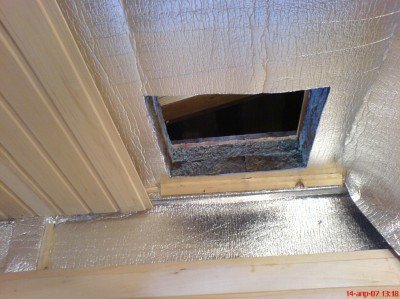
The hole for the pipe outlet must be designed taking into account fire safety requirements
Important: when insulating the ceiling, it is necessary to properly issue the pipe outlet. The distance from the ceiling boards to the pipe outlet must be at least 250 mm. To comply with fire safety, all the edges of the boards adjacent to the hot pipe must be covered with asbestos.
Which method of the above you would not choose, all of them are quite effective and reliable.


